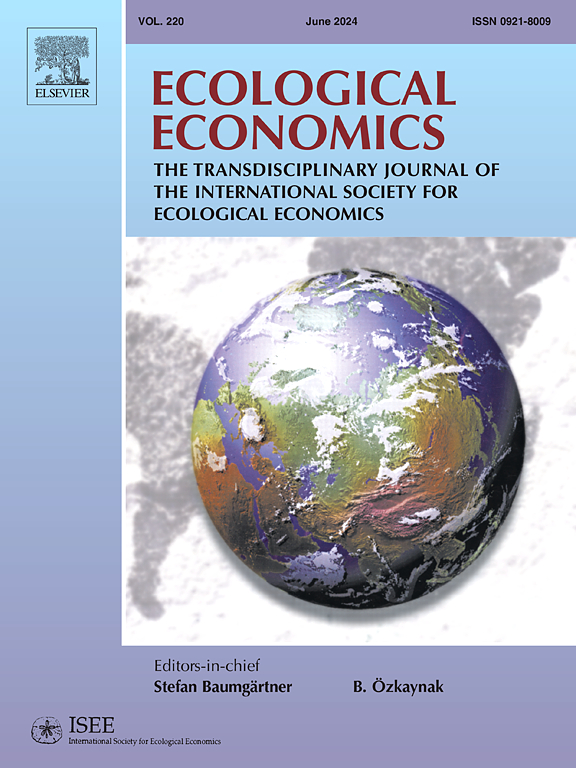降低保护区等级(PAD)对生物多样性的影响
IF 6.6
2区 经济学
Q1 ECOLOGY
引用次数: 0
摘要
我们定量评估了降级保护区(PAD)对美国生物多样性的影响。结果表明,降级保护区事件显著降低了生物多样性。与距离 PAD 事件较远的物种记录相比,距离 PAD 事件较近的 50 公里范围内的生物多样性(丰度)减少了 26.0%。我们观察到,在最近的 PAD 事件发生后,丰度总体下降了 32.3%。与水接触的生物和非哺乳动物的丰度下降幅度更大。在 PAD 事件的决定后来被推翻的地区,以及靠近属于世界自然保护联盟(IUCN)类别的保护区的地区,物种丰度对负面影响更为敏感。在 1903 年至 2018 年期间,美国颁布的 PAD 事件因丰度下降导致了约 6.8995 亿美元的经济损失。我们的研究结果有助于理解 PAD 事件等环境干预措施对大规模生物多样性变化的影响,并为生物多样性保护政策提供了重要启示。本文章由计算机程序翻译,如有差异,请以英文原文为准。
The impact of downgrading protected areas (PAD) on biodiversity
We quantitatively assess the impacts of Downgrading Protected Areas (PAD) on biodiversity in the U.S. Results show that PAD events significantly reduce biodiversity. The proximity to PAD events decreases the biodiversity (abundance) by 26.0 % within 50 km compared with records of species further away from the PAD events. We observe an overall 32.3 % decrease in abundance after those nearest PAD events are enacted. Abundance declines more in organisms living in contact with water and non-mammals. Species abundance is more sensitive to the negative impacts in areas where the decisions of PAD events were later reversed, as well as in areas close to protected areas belonging to the International Union for Conservation of Nature (IUCN) category. The enacted PAD events between the period 1903 to 2018 in the U.S. led to economic losses of approximately $689.95 million due to the decrease in abundance. Our results contribute to the understanding on the impact of environmental interventions such as PAD events on broadscale biodiversity change and provide important implications on biodiversity conservation policies.
求助全文
通过发布文献求助,成功后即可免费获取论文全文。
去求助
来源期刊

Ecological Economics
环境科学-环境科学
CiteScore
12.00
自引率
5.70%
发文量
313
审稿时长
6 months
期刊介绍:
Ecological Economics is concerned with extending and integrating the understanding of the interfaces and interplay between "nature''s household" (ecosystems) and "humanity''s household" (the economy). Ecological economics is an interdisciplinary field defined by a set of concrete problems or challenges related to governing economic activity in a way that promotes human well-being, sustainability, and justice. The journal thus emphasizes critical work that draws on and integrates elements of ecological science, economics, and the analysis of values, behaviors, cultural practices, institutional structures, and societal dynamics. The journal is transdisciplinary in spirit and methodologically open, drawing on the insights offered by a variety of intellectual traditions, and appealing to a diverse readership.
Specific research areas covered include: valuation of natural resources, sustainable agriculture and development, ecologically integrated technology, integrated ecologic-economic modelling at scales from local to regional to global, implications of thermodynamics for economics and ecology, renewable resource management and conservation, critical assessments of the basic assumptions underlying current economic and ecological paradigms and the implications of alternative assumptions, economic and ecological consequences of genetically engineered organisms, and gene pool inventory and management, alternative principles for valuing natural wealth, integrating natural resources and environmental services into national income and wealth accounts, methods of implementing efficient environmental policies, case studies of economic-ecologic conflict or harmony, etc. New issues in this area are rapidly emerging and will find a ready forum in Ecological Economics.
 求助内容:
求助内容: 应助结果提醒方式:
应助结果提醒方式:


